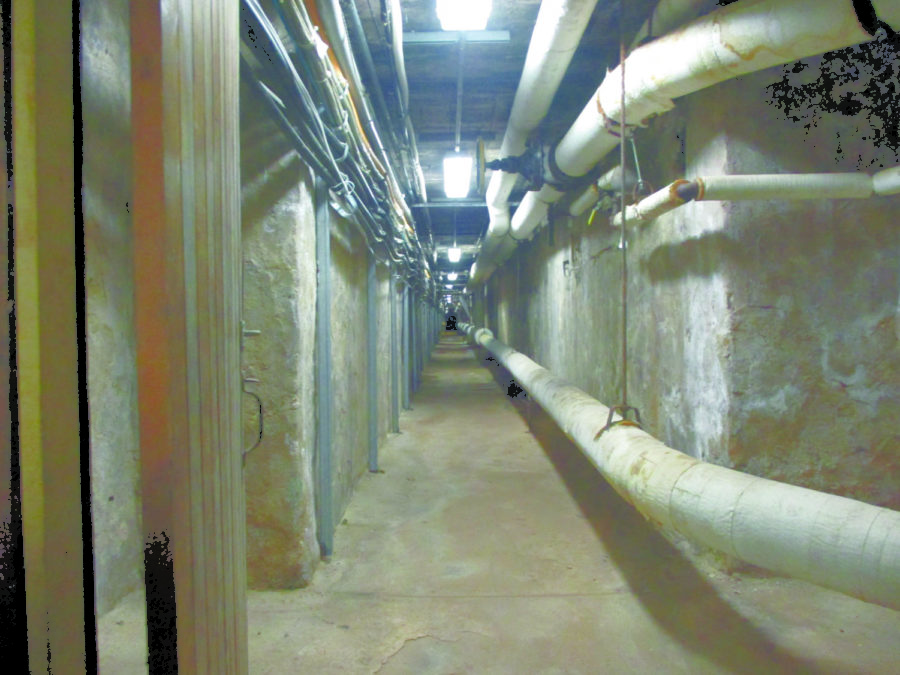Tyler Hall is an elegant mansion that sits upon a hill, looking over Neshaminy Creek, with unforgettable gardens and beautiful scenery – but underneath that mansion lies a long, narrow, and secret passageway.
I met with Tobi Bruhn, vice-president of Advancement and Executive Director of Foundation and Alumni Relations. He was excited to show me this mysterious tunnel.
Bruhn and I climbed down the stairs to reach the basement of Tyler Hall. “The tunnel is a thing of interest, not many people know about them,” told Bruhn.
We entered the basement, and it was filled to the brim with boxes of files and papers. The basement was spacious, and there was only a narrow path carved out of the plastic bins to wade through.
“They’re planning on cleaning house down here soon,” he told me as we passed a stack of bins that had fallen and spilled its contents all along the pathway.
After minutes of walking, we reached our destination: a rectangular opening in the wall with an odd warmth shooting straight out of it.
It was the tunnel.
Many pipes and wires snaked their way along the walls, while overhanging lights threatened to bang into your head if you weren’t too careful. At the end of this tunnel should be the basement of the Orangery – but all we could see was pitch black. We started our trek into the tunnel. The walls looked like they were once smooth, but had deteriorated somewhat to the test of time. Cracks and discoloration plagued the wall.
Dust was caked on everything. In between dodging low lights and protruding pipes, all I could smell was dust, earth, and humidity.
“You have to watch your head,” warned Bruhn, “Stella Elkins Tyler was probably short, so she really didn’t have to worry about hitting her head.” The warning was a minute late, unfortunately. “I’ve hit my head many times,” he winced.
As we passed an alcove, Bruhn recounted, “Sometimes we give parents and kids tours of the tunnel, because what kid doesn’t like that sort of thing.”
“Usually, they run ahead and get to this light-switch here and turn off the lights,” he laughed. With no other source of light, the tunnel would be pitch black.
We escaped the narrow corridor with minimal trauma, and entered the basement of the Orangery. Inside was a boiler, and a stone furnace in the corner.
As we left the building, with the tunnel behind us, I realized that many didn’t even know about its existence.
The Centurion previously reported on the tunnels in 2008 but students were still surprised to hear about them.
Usman Yaftali, the vice-president of the Muslim Student Association club was shocked when I mentioned it to him. “I have been here for 2 and a half years, and I never knew about them,” he said.
Hamzah Dabbour, a freshman majoring in engineering, was also surprised. “Are you for real?”
The tunnel was created in the early 1930s during the mansion’s construction.
“We were told by members of the Tyler family that Stella Elkins Tyler used the tunnel for convenient access to the Orangery and greenhouse,” said Bruhn. She would use it to get access to her art studio.
The tunnel was also used often by servants and staff to get to refrigeration facilities, especially during the colder and stormy weather.
Nowadays, it is locked up tight. It is visited only during the occasional tour of the mansion or by a badgering reporter trying to get a scoop – otherwise, the tunnel is locked to any student or staff.
It holds utilities like steam, telecom, and heating along the walls, giving a warm, humid feeling throughout the tunnel.
When asked if there had been any cave-ins, Bruhn said, “Fortunately not!” The maintenance of Tyler Hall ensures that this tunnel will stay safe.
“Repairs above the tunnel will be made during the Spring (on the sidewalk),” mentioned Matthew Metcalf, Historic Preservation Program Coordinator.
Bruhn expanded on that, “the sidewalk is in pretty bad shape – we’ve had to replace it about three times now.” It is very susceptible to the harshness of snow and water, and it easily breaks.
Also, the foot traffic and vehicles don’t help matters much either.
There have not been any accidents in the tunnel as far as Bruhn knows, but that doesn’t mean they are empty of any living beings. Rodents and snakes hide in holes and sneak around.
Still, it’s only a small footnote in the history of a rich Bucks County family.
The Tyler family was a significant land-owning family, acquiring nearly 2,000 acres of land. 200 acres of that property was to be given to Temple University, and the rest turned into Tyler State Park.
Temple University sold the land to the Bucks County Authority. With that land, they broke soil on what would become Bucks County Community College.
The Tyler family may have used the tunnel as a convenient passageway between the Orangery and Tyler Hall.
Today, it is a curious, secret remnant of the family’s history that creates stories for children, and opens the door to learning about the intricate history behind Bucks and the Tyler family.


